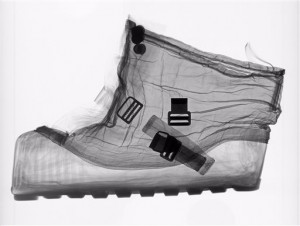Space art eyes creativity in tech at Smithsonian

This handout image provided by the Smithsonian National Air and Space Museum shows an X-ray of an extravehicular (EV) overshoe that was designed to be worn over the Apollo spacesuit boots while an astronaut was walking on the Moon, part of a new art exhibit at the museum entitled: “Suited for Space,”opening Friday that highlights the creativity behind the suits that allowed humans to explore the moon and aspire to fly further from Earth. AP Photo/Mark Avino, Smithsonian National Air and Space Museum
WASHINGTON—The familiar exteriors of astronauts’ spacesuits often hide all of the ingenuity and mechanics that are built inside the suits, which were first imagined as “wearable spacecraft.”
Now a new art exhibit, “Suited for Space,” opening Friday at the Smithsonian’s National Air and Space Museum, highlights the creativity behind the suits that allowed humans to explore the moon and aspire to fly farther from Earth.
X-ray images and photographs show the suits in intricate detail, said space history curator Cathleen Lewis. The museum’s X-rays are the first such images ever created to study, conserve and research the nation’s spacesuits.
“You don’t realize what a complex machine these are,” Lewis said. But the X-rays of Alan Shepard’s Apollo spacesuit and a 1960s prototype “allow visitors to see beyond what is visible to the naked eye, through the protective layers of the suit to see the substructures that are embedded inside.”
The exhibition traces the evolution of the spacesuit from the early high-altitude test flight suits of the 1930s to the dawn of the space age with Mercury, Gemini, Apollo and space shuttle missions.
Article continues after this advertisementWhile technology drove much of the suit design to maintain an airtight barrier to the vacuum of space and to protect from solar radiation, fashion aesthetics of the time also played a role, Lewis said. The original Mercury seven astronaut suits were unique from all others with a silvery coating to introduce America’s space explorers to the world.
Article continues after this advertisement“NASA had a demand to create the astronauts into a whole new corps, a non-military corps. So here was an opportunity to dress them in a new uniform … that evokes sensibilities of that Buck Rogers imagination,” she said. “All of these guys, the engineers, they grew up on science fiction. They fed it with their ideas, and they were consumers of it at the same time.”
Curators are working to find ways to preserve spacesuits because some materials are decomposing, discoloring or becoming rigid some 50 years after they were created.
The spacesuit show is traveling to 10 cities, moving next to Tampa, Florida, Philadelphia and Seattle through 2015.
Two companion exhibits at the National Air and Space Museum also highlight 50 artworks of about 550 new items added to the Smithsonian’s growing space art collection over the past decade. They include portraits of astronomer Carl Sagan and astrophysicist Neal deGrasse Tyson, and a photograph of first female shuttle commander Eileen Collins by photographer Annie Leibovitz.
The museum’s art collection includes 7,000 paintings, drawings, prints, posters and sculptures. Curators have been working to add more contemporary and conceptual art over the past 10 years.
Chief Curator Peter Jakab said art helps people reflect on aerospace achievements and the humanity imbued in each machine.
Albert Watson, a photographer known for his portraits of celebrities, such as Steve Jobs, and of fashion, took a break in 1990 to photograph spacesuits and other artifacts. More recently, he donated two large-scale prints of an Apollo glove and boot to the museum.
Watson said he was captivated by the thought of suits that traveled in space and came back covered with moon dust.
“When you deal with celebrities every day or super models every day and fashion people every day, there is always a nice escape to go into still life,” he said. “As a child, I loved science fiction. I always remember arguing with my father about rocket ships. He said man will never go into space, he said, because what goes up must come down.”
The museum also has acquired a sculpture by Angela Palmer that evokes 46 different earth-like worlds that have been discovered by NASA’s Kepler Observatory. The piece, entitled “Searching for Goldilocks,” involves 18 sheets of glass marked with circles for each star with an orbiting planet.
It refers to “Goldilocks” planets that might support life. They range from 132 light-years to about 4,300 light-years away.
“If you have a look, you can stand there looking from Earth, as if you are the eye of the telescope,” she said. “Or you can go to the back of the sculpture, and you can be thrown back towards Earth — 4,300 light years straight back down.”